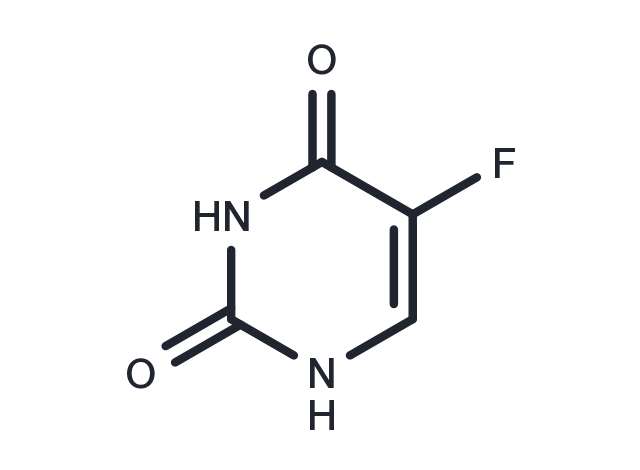Powder: -20°C for 3 years | In solvent: -80°C for 1 year
5-Fluorouracil (5-FU) is a uracil analog, an inhibitor of DNA synthesis. 5-Fluorouracil has antitumor activity and affects pyrimidine synthesis through inhibition of thymidylate synthase. 5-Fluorouracil causes apoptosis and autophagy.

| 説明 | 5-Fluorouracil (5-FU) is a uracil analog, an inhibitor of DNA synthesis. 5-Fluorouracil has antitumor activity and affects pyrimidine synthesis through inhibition of thymidylate synthase. 5-Fluorouracil causes apoptosis and autophagy. |
| In vitro |
METHODS: Human cardiomyocytes HCM, human umbilical vein endothelial cells HUVE, and human colon cancer cells HCT116 and HT29 were treated with 5-Fluorouracil (0.01-1000 µM) for 24-96 h, and the growth inhibition of the cells was detected by MTT. RESULTS: The EC50 of 5-Fluorouracil on HCM, HUVE, PHCT116 and HT29 cells were 4.866 μM, 3.832 μM, 13.72 μM and 106.8 μM, respectively, at 72 h. [1] METHODS: Smooth muscle cells were treated with 5-Fluorouracil (0.05-10 mM) for 24 h. Apoptosis was detected using Flow Cytometry. RESULTS: 5-Fluorouracil at concentrations of 0.1, 1, and 10 mM induced apoptosis in cultured smooth muscle cells after 24 h of treatment, and the apoptotic cells were detached from the culture dishes. [2] METHODS: Human colon cancer cells SW620 were incubated with 5-Fluorouracil (13 μg/mL) for 24-48 h. ALP activity was detected using an ALP detection kit. RESULTS: Alkaline phosphatase (ALP) has been used to monitor the differentiation effects of certain anticancer compounds. Untreated SW620 cells showed relatively low ALP activity, while in cells treated with 13 μg/ml 5-FU, ALP activity reached high levels in a time-dependent manner. [3] |
| In vivo |
METHODS: To detect the antitumor activity in vivo, 5-Fluorouracil (10-40 mg/kg) was injected intraperitoneally once a day for ten days into mice bearing ascites hepatocellular carcinoma tumor H22. RESULTS: 5-Fluorouracil at 10 mg/kg inhibited tumor growth while maintaining immune function in mice. 5-Fluorouracil exerts low-dose, low-toxicity antitumor effects and stimulates the host immune system. [4] METHODS: To study 5-Fluorouracil-induced intestinal injury, 5-Fluorouracil (100-200 mg/kg) was administered as a single intraperitoneal injection to BALB/c mice. RESULTS: The body weight and diarrhea symptoms of 5-Fluorouracil-treated animals were significantly reduced in a dose-dependent manner. Occludin and claudin-1 protein expression was significantly reduced in the 5-Fluorouracil-treated group. 5-Fluorouracil-treated group showed significantly higher NF-κBp65 protein and TNF-α mRNA expression than the control group. NF-κBp65 protein and TNF-α mRNA expression were significantly higher in the 5-Fluorouracil treated group than in the control group. [5] |
| 細胞研究 | After a 7-day habituation period, the mice were divided into three groups (vehicle group, dextrin group, and ED group; n = 6 mice per group) that had the same mean body weight (time of grouping was designated as day 0). Then, mice were treated by tail vein injections from day 0 to 4; mice in the dextrin and ED groups received 40 mg/kg/day of 5- fluorouracil (5-FU) injection 250 mg, while mice in the vehicle group received 10 mL/kg/day physiological saline, which was equivalent to the dose of 5-FU. Additionally, twice a day from day 0 to 6, ED group mice received 1.6 kcal/0.8 mL/day ED administered orally, while mice in the vehicle and dextrin groups received dextrin containing the same amount of calories. Body weight and food consumption were measured before administration of 5-FU and ED on days 0 and 7. Food consumption was measured with respect to each group. Mice were accommodated individually in specially prepared polycarbonate cages, and two or more fresh stools per mouse were scored as follows: 0, the stools were not crushed when pushed by human fingers; 1, the stools were crushed, but the core remained when pushed by human fingers; 2, the stools were crushed and the core did not remain when pushed by human fingers; 3, the stools were crushed and stuck to the fingers when pushed by human fingers; 4, the stools lost their shape just from being touched. Autopsies were conducted on day 7. After bleeding, the large intestine (the colon and rectum) was taken, and the length was measured. The lumen was washed with physiological saline, the excess water was wiped off, and specimens were weighed. Section 3 cm distal from the center of the large intestine was fixed with formalin for histological evaluation. Salivary glands (the submandibular gland and sublingual gland) were collected and weighed. The collected salivary glands were fixed with formalin, and after the tissue sections were prepared, they were stained with hematoxylin and eosin [3]. |
| 別名 | 5-FU, Fluorouracil, NSC 19893, 5-Fluoracil |
| 分子量 | 130.08 |
| 分子式 | C4H3FN2O2 |
| CAS No. | 51-21-8 |
Powder: -20°C for 3 years | In solvent: -80°C for 1 year
Ethanol: 1.3 mg/mL (10 mM)
DMSO: 18.33 mg/mL (140.94 mM)
You can also refer to dose conversion for different animals. 詳細
bottom
Please see Inhibitor Handling Instructions for more frequently ask questions. Topics include: how to prepare stock solutions, how to store products, and cautions on cell-based assays & animal experiments, etc.
5-Fluorouracil 51-21-8 Apoptosis Cell Cycle/Checkpoint DNA Damage/DNA Repair Metabolism Microbiology/Virology Proteases/Proteasome Nucleoside Antimetabolite/Analog HIV Protease Endogenous Metabolite DNA/RNA Synthesis 5-FU 5 Fluorouracil inhibit Fluorouracil NSC19893 Inhibitor 5Fluorouracil Human immunodeficiency virus HIV NSC 19893 5-Fluoracil NSC-19893 inhibitor
